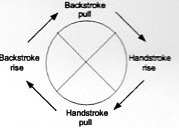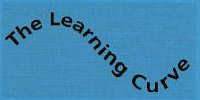The Learning Curve - A regular feature in The Ringing World, by John Harrison.
Sponsored by the Central Council Education Committee
www.cccbr.org.uk/education/
Fighting the bell
(Volume 1, Chapter 29)
Ringing tutors see two problems over and over. They happen to most learners at some stage, but some ringers well past 'learners' suffer too. The two battles are fought in opposite directions: one to stop the bell dropping and the other to stop it crashing onto the stay. Needless to say, both drain a lot of energy from the hapless victim and both ruin the striking.
Getting wound up
We are told not to over-pull (at least we should be) but heeding the advice is not always so easy. No one consciously thinks 'I will ignore that advice' but lots of ringers, especially inexperienced ones, end up over pulling none the less. Some times as well as wasting effort and striking poorly, they risk failing to stop the bell crashing through the stay. So why does it happen, and what can you do about it?
Getting wound up is a good description of how
it feels - quite frightening if you don't know what
is happening. At first things might be OK and
then you find they get worse and worse, as if the
bell is fighting you. In one sense it is, but
remember that any excess energy in the bell came
from you. You can't blame a 'fast ball' on an
opponent - there is no one else on the rope. If the
bell sends you a 'fast one', it was you who pulled
it too hard on the previous stroke.
Of course you knew that the previous stroke
was a hard pull, but didn't realise that as well as
struggling with what came at you, you were
helping to make the next stroke worse as well.
Pulling and Checking
Let's go back to basics. Making the bell do
what you want is not just about 'pulling'; it is very
much about timing, ie when to apply force to the
rope. This is so important that many ringers use two different words:
• Pulling means applying force as the rope descends; it makes the bell swing higher and therefore more slowly.
• Checking means applying force as the rope
rises; it stops the bell swinging so high, so it then
swings more quickly.
You can think of this as a four-stroke cycle,
shown diagrammatically in figure 1.

Figure 1 - The Four-stroke cycle
To be in control you need a balance between
pulling and checking, ie between force on the
rising and descending strokes. This might seem
obvious, but it is not easy until you get the hang of
it. The rise and fall of the rope at each stroke
follow in quick succession. Your arms should
make a smooth, continuous movement, but that
can hide the need for different force at different
parts of the stroke.
Switching the force
You must be able to 'switch on' or 'switch off' the force between the rise and fall, in order to vary the balance between pulling and checking. If you don't switch at the top of the stroke, you apply the same force on the way down as on the way up, which does little but wear you out. Worse still, most of us find pulling more natural than checking, so when really struggling, it's easy to pull a little more than you are checking.
Risk factors
Getting tired can increase the risk. You might
think it would reduce over-pulling, but when tired
you respond a little more slowly, and delay biases
you towards pulling. Of course, if you don't
understand the difference between pulling and
checking, it won't help either.
Unwinding
To unwind, you need to apply less force, but
you can't just stop suddenly, or the bell would
rush up and hit the stay with possibly disastrous
consequences. To get back to normal, you must
pull less while still checking quite hard (to handle
the excess energy already in the bell). Resist the
urge to follow through after the check with a
correspondingly vigorous pull.
Getting out of the wind-up is harder than
avoiding it in the first place. You might need to
do it over a few successive strokes, rather than in
one go. Be prepared also to handle any side
effects of drastic action, such as over-correcting,
or getting slightly out of place.
Dropping
The other common battle ringers fight is when
a bell continually seems to drop, despite
considerable efforts to keep it up. One expects a
badly going bell to cause problems, but when it
happens with a normal bell, it is often to do with
how it is being rung - you put a lot of effort in but
somehow it all gets dissipated.
This problem too is about pulling and checking.
The pulling is there for all to see, and the poor
soul on the end of the rope cannot intend to check
the bell, so how does it happen? Heavy
handedness is often the culprit.
Feeling v pulling
The rope is the only contact between you and
the bell. To feel what the bell is doing you must
keep the rope taut for as long as possible, but if
you keep it too tight, two things happen:
• The force affects the bell movement, even
when you don't intend it to.
• Your muscles are tighter, your feel for the
bell is less sensitive.
It can be very tempting to start pulling before the top of the swing, but if you do that, you don't feel how far the bell could have risen (especially at backstroke). In any case, it will not rise far because you are checking it. Cutting the rise short in this way is quite common, and defeats your efforts to keep the bell up.
The effect is most marked with a bell that is not
swinging up to the balance, ie when ringing
round the back, or when ringing up. There is no
clear point at which the bell goes over the balance
- near the top of the stroke it moves more slowly,
and is very sensitive to the force on the rope. It is
easy to misjudge this.
If you ring a heavier bell than normal, you need
to adapt to the way heavy bells swing. With a
bigger wheel, the rope goes up further, so if you
catch it as you would a smaller bell, you will find
your hands too high on the sally, thus checking it
involuntarily. The secret at handstroke, when
your hands rise to meet the sally, is to mirror the
rhythm of your hands at backstroke, which also
has a longer stroke.
With a small bell, even the weight of your arms
on the rope can cause problems, especially during
the up stroke, so you must support some (but not
all) of their weight. To do that without letting the
rope go slack requires an acute feel for what the
bell is doing, so you can move your hands at
exactly the same speed as the rope.
A long pull
Another thing everyone is (or should be) told, is
to maintain sustained downward tension on the
rope for as long as practical. This ensures a well
behaved rope (with less chance to swing
sideways). It also makes whatever force you
apply more effective, so a long gentle pull can
achieve more than a short jerk. If your arms stop
part way down, you are wasting some of the
stroke and making things harder.
Striking the balance
Precision control of anything from a bell to a
bicycle, involves finding and keeping a balance
between opposite trends. With a bike, falling off
to right or left feels the same (except where you
get bruised) and the correction mechanisms are
obvious, though over correction can cause
wobbling.
With ringing too, over correction is a problem,
if you don't anticipate when you have nearly
corrected things and back off. What makes
ringing harder is that a bell feels very different
when dropping or going too high. Add to that the
counter intuitive fact that pulling the bell makes it
ring more slowly rather than more quickly, and
the rather unhelpful fact that when you need to
pull most (because your bell is dropping) your
rope goes floppy, and it is not hard to see why so
many ringers struggle.
Solving the problem
You can avoid the problems if you:
a - understand what happens
b - can feel what your bell is doing
c - can 'switch' the force during the stroke
These are inter-dependent. You need (b) to
know when to do (c) and you need (a) to make
sense of it all. The key is the feeling - something
you need to keep on developing after mastering
the basic ability to handle the bell. Exercises like
ringing to the balance with extended pauses (not
touching the stay) are not just for beginners.
Doing it ten times on the run at hand and back is a
useful competence test that all of us should
occasionally try to perfect.
Another useful exercise is to reduce the overall
force on the rope (without letting the rope go
slack) while maintaining full control of your bell.
A light touch makes it easier to feel what is
happening, and easier to switch the force on and
off exactly as needed.
If you have problems with these exercises, try
adjusting your rope length. Half an inch can turn
good control into only adequate control. Two or
three inches can make it impossible. Practice
making continual adjustments and learn what the
right length feels like. Learn to adjust the length
while ringing.

Reprinted from The Ringing World 2 November 2001. To subscribe, see www.ringingworld.co.uk/ or call 01264 366620
Collections of monthly Learning Curve articles are available in book form from CC Publications www.cccbr.org.uk/pubs/
or they are free to read at www.cccbr.org.uk/education/thelearningcurve/


